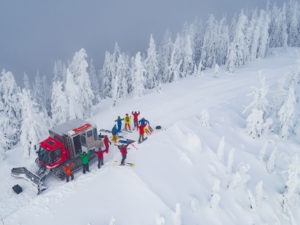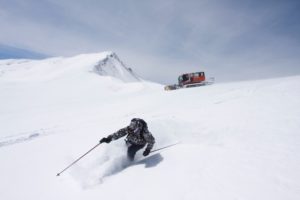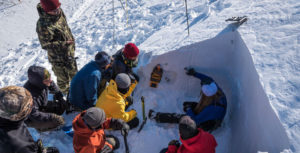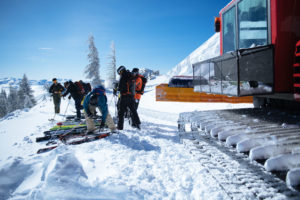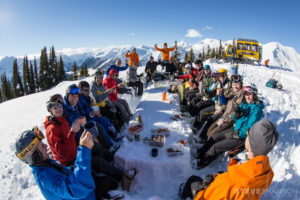What is Cat Skiing
Cat skiing is a guided backcountry experience using a snowcat (think tractor with cat-tracks for wheels) to bring you to the top of the mountain instead of a traditional ski-lift. The benefit is that most of the terrain in the backcountry is untracked powder—giving you almost unlimited options for an epic ride. You also won’t have to deal with lift lines, crowded lodges, and freezing cold lifts back to the top.
What we love about Cat Skiing
Barring a trip to Japan or the use of a helicopter, this is probably the best way to almost guarantee fresh powder on any given day. Cat skiing is also way cheaper than the first two options. Not only that, many cat-skiing experiences come complete with breakfast and/or lunch packages to make it easier to get your runs in.
We also love that these are guided backcountry operations where someone has always got your back. Because of this, cat-skiing is considered to be one of the safest ways to experience backcountry skiing.
Why not splurge a little and get the powder day you always dreamed of? Given the cost of lift tickets, lunch at the lodge and the hassle of long lift lines, it ‘s totally worth the price. Plus, you get so much more powder.
What to expect
Booking
Most major resorts have a cat skiing operation close by or even as part of their resort services. You’ll want to book your cat-skiing trip in advance. There are limited spots available and they book up rather quickly especially during peak season. To make sure you get a spot, book your cat-skiing excursion well in advance. (Note: some of the larger operations fill up 10 months in advance.) Booking early also gives you time to prepare (i.e., get in shape) for your trip.
Tip:
If you get enough of your family/friends together you can
book a private trip and have the mountain to yourselves for the day.
Safety First
Cat-skiing usually begins around 8 am. Some outfits include breakfast which starts around 7 am. Breakfast is typically followed by backcountry safety instructions. Guides go over avalanche safety and backcountry guidelines. They will also go over gear such as avalanche beacons, shovels, search poles, etcetera. Don’t panic. These are all just safety measures to ensure against worst-case scenarios. Your snowcat guides will not take you to avalanche risk areas. Once you’ve got all your instructions, They’ll split you into groups base on skill and fitness levels. Each group will get their own snowcat and be given a separate set of instructions specific to your destination on the mountain.
On the Mountain
After safety instructions, you and your gear will be loaded in the snowcat and taken up the mountain for your first run. At the top, your guides will help you get situated and outline the best routes to get down. They will also point out the best lines to take down as well as any hazard you should look out for. Folks will generally go down in pairs (buddy system) towards a designated pick-up spot where the snowcat will meet you. When the entire group gets to the bottom, you go up and do it all over again.
Expect to be skiing the whole day with snack/lunch breaks in-between runs. The idea is to maximize your runs. Most folks will get 8-12 trips up the mountain depending on your group’s skill and fitness levels. It may not seem like a lot of runs but believe us—12 runs is more than most legs can handle in a day. You’ll be sking the whole mountail top to bottom. This is not one of those—3 lifts and a traverse to get to the top—kind of days. You’ll be riding the snowcat express to the top every time.
The guides try to group you based on your skill level but your fitness will be the real determining factor for most people. Obviously the fitter you are, the more runs you’ll be able to get in. Feel free to sit one out if you need a rest but that just might be the run of the day you’re missing out on.
Your day will end between 3 and 4 in the afternoon with everyone telling stories about their best run of the day.
Required Gear
No need to go out and buy any special gear. If this is your first cat-skiing experience, you’ve got nothing to worry about. Avalanche safety gear is always provided. Powder specific skis/snowboards are also typically available from your snowcat outfitter at a reasonable rate. Aside from that, you should have a ski pack, helmet, and a good pair of goggles. We also suggest you have your skis tuned for backcountry use. Setting your din level a little higher will decrease the chances of you losing your skis in the snow (not an issue for snowboarders). The rest is up to you.
Rates
Cat skiing rates will differ dramatically based on the location and size of the operation. Some resorts offer cat-skiing as part of or in addition to their regular lift pass. These rates are often cheaper ($0-$100) but the access to skiable terrain is somewhat limited and the guarantee of fresh powder is as well. Larger operations often run independently from the resorts and are more expensive but have access to a vast amount of terrain for intermediate to expert level skiers/snowboarders. These are the ones we recommend.
A day out with these snowcats will run $400-600 per person but include meals, guides, safety training, and your all-day express ride to the top of the mountain. There are also multi-day packages available that include meals and accommodations. These trips can typically run over $1,100 per day but everything is included.
Yes—it’s expensive but consider how many days you’ve spent on the groomers at resorts searching for those little stretches of side-country powder. Think about your last/best powder day and how great that experience was. Cat skiing is all of that without the lift lines and the crowds. It’s just powdered bliss all-day. If you’re still reading this and the price-tag won’t break the bank, you’ll definitely find the ride worth the price of admission. The experience is truly unforgettable.
Tip:
Cat-skiing rates outside of North America can be dramatically less due to exchange rates and other factors. It’s well worth looking into—especially if you want to guarantee a powder day on your trip to Chile or Argentina.
Best Places to cat Ski
Cat skiing can be found near most major resorts. There are even a few East-coast resorts that offer it now. The best North American cat skiing is found out West. Cat skiing outfitters in Colorado, Utah, and especially British Columbia are among the oldest and most trusted in the business. If you want to incorporate a day or two of cat skiing in with your trip, call ahead to make sure there is a trusted cat skiing operation close by. Our favorite places for cat skiing are in British Columbia where the terrain is vast and the snow is deep. Below is a list of resorts where we offer cat-skiing packages.
Utah:
Park City
British Columbia:
Revelstoke
Sun Peaks
Fernie
Whistler
Chile:
El Arpa
Argentina:
Bariloche
Japan:
Niseko
Tips for First-Timers
Train For It
Although you don’t have to be an expert skier/snowboarder to have a great cat-skiing experience, you should train for it. Cat-skiing is a full-day excursion. Folks who aren’t used to skiing a full day will be hard-pressed to keep up with the rigors of non-stop skiing all day. You won’t want to be the one who slows the whole group down because your legs are giving out on you. Get in some strength/endurance training before you go and you’ll be in a much better place. Running, squats and cycling are all great training exercises but the best way to train for a cat-skiing trip is to hit the slopes as often as possible prior to your trip.
Take a Break
When you’re on these trips you’ll find that even some of the most experienced skiers need to take a break once in a while. Don’t be afraid to sit out a couple of runs to get your legs back. Skiing powder is a lot of work so you have to pace yourself. Don’t beat yourself up if you miss out on a couple of runs. It’s more about quality than quantity. Take a break, refuel, and head back out when you’re ready to go again.
Backcountry Safety
You will get some backcountry training during your cat-skiing experience but its best to do a little research on your own so you know what to expect—especially if you’re new to it. At the very least you should watch a couple of youtube videos about it to get comfortable with the concepts of backcountry skiing, wilderness first aid, and avalanche safety. The chances of you having any kind of issues are pretty remote but it’s always good to be prepared.
Powder Gear
As we said, most cat skiing outfitters will provide powder ski/snowboard equipment but you may want to invest in some proper ski-wear. We suggest a layering system (base layers, thermal layers, wind/waterproof shell). Make sure your shell has venting options to allow you to shed heat and moisture. The snowcats are typically heated so heat regulation and moisture control are paramount to staying dry and comfortable both on and off the slopes. Ski bibs and a jacket with a snow skirt are a great way to keep the snow from getting in where it shouldn’t be. We also recommend a helmet with vents to keep you from overheating. Last but certainly not least, a high-quality pair of goggles to keep your vision intact while you’re floating through the powder. Remember, clothing is one of the most important parts of your ski gear so come prepared.
Have Fun
Don’t be intimidated. As we said, there are guides to help you and keep you safe. Cat skiing the backcountry is a lot like skiing the resorts on a powder day only you don’t have to deal with the lift lines or the crowds. Stay in your comfort zone for the first couple of runs. When you’re comfortable, try to push your limits a little to really get the most out of the experience. Cat skiing is all about having fun. After your first trip, you’ll be wondering why you didn’t try it sooner.


